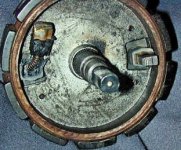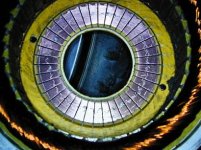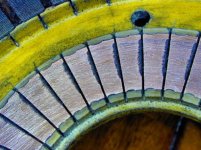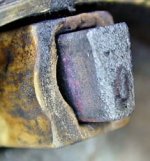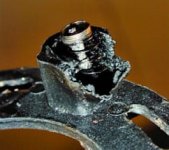OK, getting nearly finished. Went for a short (12 mile), but educational ride today.
But first some photos:
Here is the mount I made for the Watts Up meter, out of aluminum:

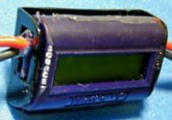
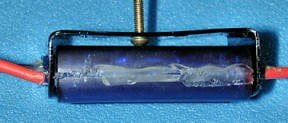
ran the bolt through the normal holes of an old handlebar mount... I think from an old rearview mirror, to mount it to the handlebars.
The Watts Up monitors the front pack, a Cycle Analyst monitors the rear.
Oh yeah; I also opened up the Watts Up and replaced the 14Ga wires with 12ga silicone wire... I feel a little better about pumping the watts through the heavier wire. Would have gone with 10ga if it would have fit without wrecking the case: I was able to melt the wire channels out with a soldering iron to fit the 12ga wires pretty well, but 10ga just wouldn't fit.
Wiring is a mess:
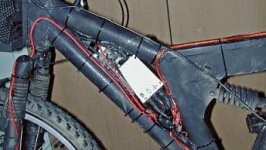
the other side isn't much better:
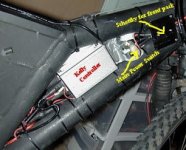
Solution: Make a cover out of aluminum sheet:

Here are the supports I added to the rear rack to help support the 22 or so pounds of the batteries and whatever when I'm riding the rough trails:
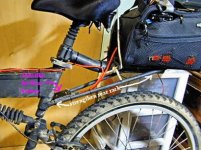
I'd have liked to use a wider angle on those supports for greater strength, but there just wasn't any practical way of doing it without getting in the way of suspension travel.
Photo also shows the location of the Schottky diode for the rear battery pack... I originally had it inside the bag with the battery, but, even on a piece of heatsink it got too hot with no air around it . Stays nice and cool even under heavy load where it is now.
Ignore the white rope between the seat and the rear pack ... That's just part of my ceiling mounted hoist to keep the bike standing up, and the wheels off the floor when I need to make sure things are running right.
(and ignore the plastic parts bins in the background, too)
I'm not even going to show you any details of the front battery rack. In fact, I'm so ashamed of the workmanship on it that I have the horrible welds and stuff covered up with that rubberized toolbox liner mesh. But it seems to be plenty strong enough, so I'm not going to be too upset about it,
(as long as someone doesn't laugh) :lol:
Since that front rack is mounted to the head tube, and is a solid part of the frame, rather than hanging from the handlebars, it kind of throws you off mentally-visually when you turn the wheel but cant actually see it move... But I think it handles better than if the whole 22 or so pounds of the front battery pack moved with the handlebars. In fact, I had to make a quick zig-zag maneuver at speed, today, that I thought was a sure crash, but it handled better than I assumed the bike and my old-man riding skill level were capable.
So, here is what the whole thing looks like right now:

Yeah, that color really looks horrible.... And I thought the camo paint job from the Mk1 phase was tacky. I started to not like it when I was half way through with putting it on, but after some guy that I talked to on my ride today thought I was trying to make it look like an old Nazi scout cycle from WWII, I
really didn't like it, because the last thing I want is for people to actually notice it. I think I'm going back to the dark charcoal gray primer that I had on it last week. (More layers of paint makes the frame stronger, right


That orange thing on the left side of the handlebar is an inclinometer (bubble level)... I think I'll take it off in the near future, but I wanted to be able to report what kind of hills I could climb without pedaling.
-----------------------------------------------------------------------------------------------------
Thanks to Justin from ebikes.ca for the advice on the Cycle Analyst, I think I have all the problems worked out with that. I kind of abused the stock shunt trying to solder on a heavy connector on just a short stub of wire from the shunt, then TRYING to desolder it when I decided to hook things up differently. It may have still worked nonetheless, but since I had a n extra 100A shunt laying around, I decided in the long run I'd be better off with it, even though it is a lot bulkier.
My problems with the speedometer function of the CA were two fold, both of which Justin helped me to figure out, despite him being on a cross country cycle trip at the time...
(so Kudos to Justin and Zev at ebikes.ca.).
Anyway, the first problem was that one of the wires from the sensor where it connected to the CA circuit board had a couple of tiny strands that had either frayed loose under my handling, or not perfectly soldered at the factory had shorted intermittently to the next solder pad over. Easily fixed once I knew where to look. The other problem was that the speedometer would go to 0.00 as soon as I actually ran any power to the motors. I figured it had to be that the magnetic fields from the motors and/or controller had to be screwing it up, since the two wired and one wireless regular bike speedometers I tried all did the same thing. I thought magnetically shielding all but the front part of the reed switch in the sensor might do the trick, but that didn't help at all. So Justin suggested using a shielded cable from the sensor to the meter guts. BRILLIANT! That did the trick.
I thought I had some extra shielded 2 conductor cable around here from some earlier project, but couldn't find it. Local Radio Shack didn't stock any either. Fortunately I had an unneeded shielded USB 2.0 cable that worked fine. Less flimsy than regular speedo cable as well.
-------------------------------------------------------------------------------------------------------------
I ordered one of those EagleTree eLoggers, was planning on using it to monitor the TOTAL power situation, rather than having to do the math to combine the WU and the CA. And I thought maybe I'd even get the GPS logger for it in the near future. Well, it worked 'on the bench' on 12 V pretty well, and while I thought that the 12ga wires on it , despite being short, were a little light to be handling the claimed 150 Amps efficiently for more than a moment, I got it programmed and everything, but when I hooked it up to my 44V system things didn't work out so well.
I powered it up with just the rear battery pack,
(didn't turn on the front pack or turn on the master switch to the controller) The 'welcome/startup ' message on the power panel just stayed on for a minute or so, but did not progress into actual operation. I recycled the battery switch; there was a small flash from inside the eLogger like a surface mount resistor of capacitor blew and both the logger and the power panel went dead.
The kind of funny thing was that I tried it out on the computer after that, and it would read voltage from 12V and 16V sources OK via the USB connection for a moment, then shut down with an error message. Did that a couple of times, then the COMPUTER program wouldn't load and run at all. I even tried uninstalling it and reinstalling the program, and it wouldn't run, with or without the logger attached. I guess the Eagle Tree software only allows a couple of errors before it does something, probably in the Windows Registry, that doesn't get cleared with an uninstall, to keep you from abusing the eLogger or your computer if you have fried your logger. I'm not sure if that
(if indeed that is the case) is a good idea or not. I went into the registry and edited all the lingering Eagle Tree stuff out, and was going to reload the software again, to see if it would work that way, but decided 'to heck with it'.
I wanted to just send the stuff back to Tower Hobbies for a refund, but they refused.
(I won't do business with them again). Fortunately, the guys at Eagle Tree answered my email promptly and it looks like they will probably (maybe?) fix it for no charge, so I'm not out $150
completely. I don't think I'll use it on this project anyway, even if it does get fixed, and works properly for me. But maybe it will be useful on project #2 or #3.
-------------------------------------------------------------------------------------------------------------------------------
As to my ride today, I decided to take it easy. No heavy acceleration, and avoid the steeper hills if I could. That turned out to be very educational to me. In just under 12 miles, still with some hills that most of you guys that don't get to ride on often, I didn't run the packs down to even 46 of their nominal 44V. I don't think I ever had to draw more than 80A a few times for more than a few seconds. I did let a friend (a Harley Rider) ride it for a half mile or so, and he
just had to see how fast it would accelerate and how fast it would go, so it did pull 120A for a few moments. Anyway, despite that, it seems if I am careful, even around my mountainous terrain, I can get around using only an average of 1AH per mile, at 11.5MPH average, 25.6MPH peak.
So, even around here, looks like my 50AH of batteries will get me about 50 miles range on one charge, if I am light on the throttle. I bet I could get 75 miles on a charge in Kansas

.
And those couple of cells or banks of cells that my previous 'hard ride' had me worrying about seem to not be bothered if you don't torture them. I kept them monitored for temperature, and they never got above 31°C this time, with the ambient being around 27°C. And all of my cells... er, more accurately, parallel cell banks were within .07 V of each other after the ride. So, that's a good sign.
Well, the guys at the barber shop weren't impressed with the bike when I took it by to show them
(they thought their horses were much more useful and interesting), but my Harley riding friend wanted to buy it from me, or at least have me build him one, even after he knew how much it would cost to duplicate my basic design (minus the expensive mistakes I made, of course).
---------------------------------------------------------------------------------------
Hopefully the weather cooperate next Tuesday... I've got a 'babysitter' coming in for the whole afternoon to take care of my responsibilities, and I'm going to see what the bike can do against the 'big mountain' in the photo in the previous post.
Barring something breaking, and covering that ugly paint job, I guess the next thing is building my headlights... Going to be 3 individually controllable Cree and/or Seoul Semiconductor 3 watt LED's, with different optics for different lighting patterns. I know that much. Oh, and a good handlebar mount for a GPS.
 (I still have no idea where the new grinder is... I GOTTA clean up the workshop. Every pile of stuff is buried under three piles of other stuff. ).
(I still have no idea where the new grinder is... I GOTTA clean up the workshop. Every pile of stuff is buried under three piles of other stuff. ). 










